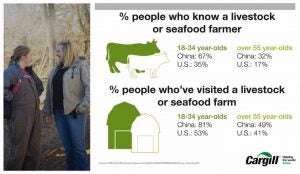Young people are living up to the “Generation Yum” label coined by author Eve Turow with their connection to the people, places, and practices that raise our food, according to new research from Cargill.
“I’m thrilled that people are deepening their understanding of agriculture,” said Hilary Maricle, co-owner of Maricle Family Farms in Nebraska, and mom of five. “By creating harmony between farmers and consumers, we can help people appreciate where their food comes from — and how innovative practices are creating healthier, more sustainable farms.”

In its latest Feed4Thought survey, Cargill found that twice as many young respondents (18-34) in the U.S. and China reported knowing a livestock or seafood farmer compared to those over 55. And while 81 percent of 18-to-34-year-old Chinese participants said they have visited a livestock or seafood farm during their lifetime, only 50 percent of their older compatriots had. Young respondents in every country surveyed were more likely to have visited a farm than those over 55, despite the fact that, globally, there are fewer farmers to know or visit today than there were a generation ago.
Generation Y (born between the early 1980s and about 2000) is also acting on what they learn about farming practices. Almost three times as many Gen Y participants (52 percent) said they had changed their eating habits for sustainability reasons in the past year versus older U.S. respondents (19 percent). Having kids at home made participants in all four sample countries more likely to make values-based changes.
This could mean anything from using blockchain to link U.S. consumers with the family farmer who raised the Honeysuckle White turkey they purchased to implementing full traceability in Cargill’s cocoa supply chains by 2030 as part of our Cocoa Promise. It could be running a sustainable beef pilot in Canada to connect customers with certified products or helping farmers improve cows’ productivity, sustainability and well-being by using Cainthus facial recognition technology to monitor individual feeding, drinking, and activity.
“The digital revolution has arrived in agriculture,” says Scott Ainslie, vice president and group director for Cargill’s animal nutrition premix business. “This will offer our customers a completely different way of making decisions and marketing their products.”
Over 80 percent of survey respondents said the way an animal is raised is important, and almost half of them were willing to pay more as a result. Chinese survey participants (59 percent) were the most open to paying a premium based on factors such as animal feed and housing; Americans (31 percent) the least. But “Generation Yum” respondents in the U.S. were more willing than their grandparents to pay for their preferred practices. Generational shifts aside, there was one thing participants of almost every age, gender, income bracket, household size, and nationality agreed on: The top responsibility of a livestock or seafood farmer, according to respondents of this global research, was producing safe food for consumers.
For farmers this could mean transparency is the key for the future. If we open up to the public about animal care on the farm, that could mean a potential increase in price of goods. Improving technology capabilities on the farm could result in a better understanding of practices used by producers.


